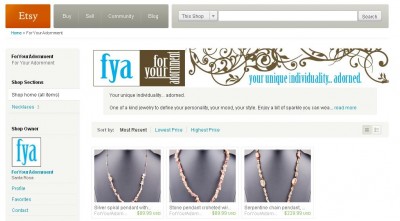Last updated on April 2nd, 2012 at 11:49 am

Drum roll please . . . after finally getting out of my own way and letting go of perfection, one of my multiple streams of income, For Your Adornment Couture Jewelry launched at www.etsy.com/shop/ForYourAdornment. This week I was able to work out the bugs in the cart that were causing the late night scratching of the head, and upload a handful of my products I have ready to go. Please take a look at the ones that are live so far and let me know what you think. Version 2.0 is already in the works, so suggestions are very welcome!
I have a hard time remembering to actually take a moment and relish the accomplishment. You probably have the same reaction because of the million directions we are pulled. The phone rings, another email is added to the inbox, your kids science project is due tomorrow, and that “win” goes unnoticed or unrecognized even by yourself.
Here are a few ways I plan to enjoy this dream success – when I get around to it this weekend . . .
- Say thank you to all my fellow 8 Women Dreamers. Without the support, understanding and good old fashioned kick-in-the-butt, I never would have embarked on this first step of my adventure. So for those of you who I don’t see on a regular basis, give yourself a mental hug until I can get to you myself.
- Turn off the computer. I hear they occasionally like to reboot, just like we do.
- Tell people! I can finally hand out my For Your Adornment card and not say “Well, there’s a temporary site up there now…”
- Work on new designs. We creative people like to do what we do, and rarely love to market it.
- Have a glass of wine. Have a bottle of wine.
- Enjoy watching my son show off the site and jewelry designs to his friends and your ex-in laws – just because he thinks its cool.
- Accept whatever compliment that comes your way – whether that is in the form of congratulations or suggestions for improvement. Its coming your way for a reason.
- Take a deep breath and check one thing off your “To Do” list. That alone is a great relief.
Take that moment to pat yourself on the back for the many accomplishments that slip by every day. If your kid is fairly clean, has a full belly, and is already asleep, take that well deserved break.
I am looking forward to the dream expanding and taking shape in more detail in the next few weeks. All your support is needed and appreciated more than I can type here.
For a fun view on how a world renowned creative and graphic designer, Stefan Sagmeister, compiles his success into what he has learned along the way, take a look at this TED conference presentation –
And here’s the transcript from the presentation –
About 15 years ago, I went to visit a friend in Hong Kong. And at the time I was very superstitious. So, upon landing — this was still at the old Hong Kong airport that’s Kai Tak, when it was smack in the middle of the city — — I thought: If I see something good, I’m going to have a great time here in my two weeks. And if I see something negative, I’m going to be miserable, indeed.
So the plane landed in between the buildings and got to a full stop in front of this little billboard. (Laughter) And I actually went to see some of the design companies in Hong Kong in my stay there. and it turned out that — I just went to see, you know, what they are doing in Hong Kong.
But I actually walked away with a great job offer. And I flew back to Austria, packed my bags. And, another week later, I was again on my way to Hong Kong still superstitions and thinking: Well, if that “Winner” billboard is still up, I’m going to have a good time working here. (Laughter) But if it’s gone, it’s going to be really miserable and stressful. So it turned out that not only was the billboard still up but they had put this one right next to it. (Laughter) On the other hand, it also taught me where superstition gets me because I really had a terrible time in Hong Kong. (Laughter)
However, I did have a number of real moments of happiness in my life — — of, you know, I think what the conference brochure refers to as moments that take your breath away. And since I’m a big list maker, I actually listed them all. (Laughter) Now, you don’t have to go through the trouble of reading them and I won’t read them for you. I know that it’s incredibly boring to hear about other people’s happinesses. (Laughter)
What I did do, though is, I actually looked at them from a design standpoint and just eliminated all the ones that had nothing to do with design. And, very surprisingly, over half of them had, actually, something to do with design.
So there is, of course, two different possibilities. There’s one from a consumer’s point of view — — where I was happy while experiencing design. And I’ll just give you one example. I had gotten my first Walkman. This is 1983. My brother had this great Yamaha motorcycle that he was willing to borrow to me freely. And The Police’s “Synchronicity” cassette that had just been released and there was no helmet law in my hometown of Bregenz. So you could drive up into the mountains freely blasting The Police on the new Sony Walkman. (Laughter) And I remember it as a true moment of happiness. You know, of course, they are related to this combination of at least two of them being, you know, design objects. And, you know, there’s a scale of happiness when you talk about in design but the motorcycle incident would definitely be, you know situated somewhere here — right in there between Delight and Bliss.
Now, there is the other part, from a designer’s standpoint — — if you’re happy while actually doing it. And one way to see how happy designers are when they’re designing could be to look at the authors’ photos on the back of their monographs? (Laughter) So, according to this, the Australians and the Japanese as well as the Mexicans are very happy. (Laughter) While, somewhat, the Spaniards …and, I think, particularly, the Swiss (Laughter) don’t be doing all that well. (Laughter)
Last November, a museum opened in Tokyo, called The Mori Museum in a skyscraper, up on the 56th floor. And their inaugural exhibit was called “Happiness.” And I went, very eagerly, to see it, because — Well, also, with an eye on this conference. And they interestingly sectioned the exhibit off into four different areas. Under “Arcadia,” they showed things like this, from the Edo period — — a hundred ways to write “happiness” in different forms. Or they had this apple by Yoko Ono — that, of course, later on was, you know, made into the label for The Beatles.
Under “Nirvana” they showed this Constable painting. And there was a little — an interesting theory about abstraction. This is a blue field — it’s actually an Yves Kline painting. And the theory was that if you abstract an image, you really, you know open as much room for the unrepresentable — — and, therefore, you know, are able to involve the viewer more.
Then, under “Desire,” they showed these Shunsho paintings — — also from the Edo period — ink on silk. And, lastly, under “Harmony,” they had this 13th-century mandala from Tibet.
Now, what I took away from the exhibit was that maybe with the exception of the mandala most of the pieces in there were actually about the visualization of happiness and not about happiness. And I felt a little bit cheated, because the visualization — — that’s a really easy thing to do. And, you know, my studio — we’ve done it all the time. This is, you know, a book. A happy dog — and you take it out, it’s an aggressive dog. It’s a happy David Byrne and an angry David Byrne. Or a jazz poster with a happy face and a more aggressive face. You know, that’s not a big deal to accomplish.
It has gotten to the point where, you know, within advertising or within the movie industry, “happy” has gotten such a bad reputation that if you actually want to do something with the subject and still appear authentic, you almost would have to, you know do it from a cynical point of view. This is, you know, the movie poster. Or we, a couple of weeks ago, designed a box set for The Talking Heads where the happiness visualized on the cover definitely has, very much a dark side to it.
Much, much more difficult is this, where the designs actually can evoke happiness and I’m going to just show you three that actually did this for me. This is a campaign done by a young artist in New York, who calls himself True. Everybody who has ridden the New York subway system will be familiar with these signs? True printed his own version of these signs. Met every Wednesday at a subway stop with 20 of his friends. They divided up the different subway lines and added their own version. (Laughter) So this is one. (Laughter)
Now, the way this works in the system is that nobody ever looks at these signs. So you’re (Laughter) you’re really bored in the subway, and you kind of stare at something. And it takes you a while until it actually — You realize that this says something different than what it normally says. (Laughter) I mean, that’s, at least, how it made me happy. (Laughter)
Now, True is a real humanitarian. He didn’t want any of his friends to be arrested. So he supplied everybody with this fake volunteer card. (Laughter) And also gave this fake letter from the MTA to everybody — sort of like pretending that it’s an art project financed by The Metropolitan Transit Authority. (Laughter)
Another New York project. This is at P.S. 1 — a sculpture that’s basically a square room by James Turrell, that has a retractable ceiling. Opens up at dusk and dawn every day. You don’t see the horizon. You’re just in there, watching the incredible, subtle changes of color in the sky. And the room is truly something to be seen. People’s demeanor changes when they go in there. And, for sure, I haven’t looked at the sky in the same way after spending an hour in there.
There are, of course, more than those three projects that I’m showing here. I would definitely say that observing Vik Muniz’ “Cloud” a couple of years ago in Manhattan for sure made me happy, as well. But my last project is, again, from a young designer in New York. He’s from Korea originally. And he took it upon himself to print 55,000 speech bubbles — — empty speech bubbles stickers, large ones and small ones. And he goes around New York and just puts them, empty as they are, on posters. (Laughter) And other people go and fill them in. (Laughter)
This one says: Please let me die in peace. (Laughter) I think that was — The most surprising to myself was that the writing was actually so good. This is on a musician poster, that says: I am concerned that my CD will not sell more than 200,000 units. And that, as a result, my recoupable advance from my label will be taken from me. After which, my contract will be cancelled, and I’ll be back doing Journey covers on Bleecker Street. (Laughter)
I think the reason this works so well is because everybody involved wins. Jee gets to have his project; the public gets a sweeter environment; and different public gets a place to express themself; and the advertisers finally get somebody to look at their ads. (Laughter)
Well, there was a question, of course, that was on my mind for a while: You know, can I do more of the things that I like doing in design and less of the ones that I don’t like to be doing? Which brought me back to my list making — — you know, just to see what I actually like about my job.
You know, one is: just working without pressure. Then: working concentrated, without being frazzled. Or, as Nancy said before, like really immerse oneself into it. Try not to get stuck doing the same thing — — or try not get stuck behind the computer all day. This is, you know, related to it: getting out of the studio. Then, of course, trying to, you know, work on things where the content is actually important for me. And being able to enjoy the end results.
And then I found another list in one of my diaries that actually contained all the things that I thought I learned in my life so far. And, just about at that time, an Austrian magazine called and asked if we would want to do six spreads — design six spreads that work like dividing pages between the different chapters in the magazine? And the whole thing just fell together. So I just picked one of the things that I thought I learned — — in this case, Everything I do always comes back to me — — and we made these spreads right out of this. So it was: Everything I do always comes back to me.
A couple of weeks ago, a (Laughter) French company asked us to design five billboards for them. Again, we could supply the content for it. So I just picked another one. And this was two weeks ago. We flew to Arizona — the designer who works with me, and myself — — and photographed this one. So it’s: Trying to look good limits my life.
And then we did one more of these. This is, again, for a magazine, dividing pages. This is: Having — This is the same thing — — it’s just, you know, photographed from the side. This is from the front. Then it’s: guts Again, it’s the same thing — “guts” is just the same room, reworked. Then it’s: always works out Then it’s “for,” with the light on (Laughter) and it’s “me.” Thank you so much. (Applause)
What have you launched this week for your own dream success story?
~ Heather
Heather’s dream is to have multiple streams of income, starting with launching an e-commerce website that showcases her one-of-a-kind designer jewelry, which are crafted by her. Her newly launched sites are couture jewelry available through For Your Adornment, For Your Adornment on Etsy.com, and Twitter background designs on Twitter And Beyond Dot Com. She also teaches Social Media tactics for business, besides being CEO of her own web design company. Heather’s post day is Thursday.

Heather Montgomery is a fitness writer, triathlete, and serial entrepreneur who is devoted to sharing what she has learned about becoming a triathlete after age 40. She uses her Metabolic Training Certification to help other women struggling to get fit in mid-life. She lives and trains in Santa Rosa, California, the new home of the Ironman triathlon. You can find her biking the Sonoma County wine trails.
Note: Articles by Heather may contain affiliate links and will be compensated if you make a purchase after clicking on an affiliate link.




